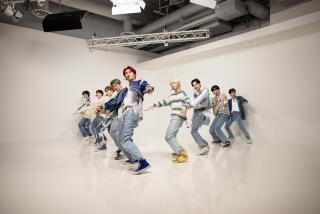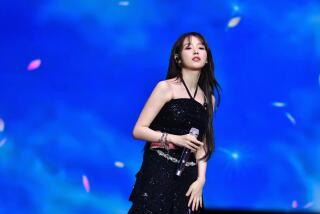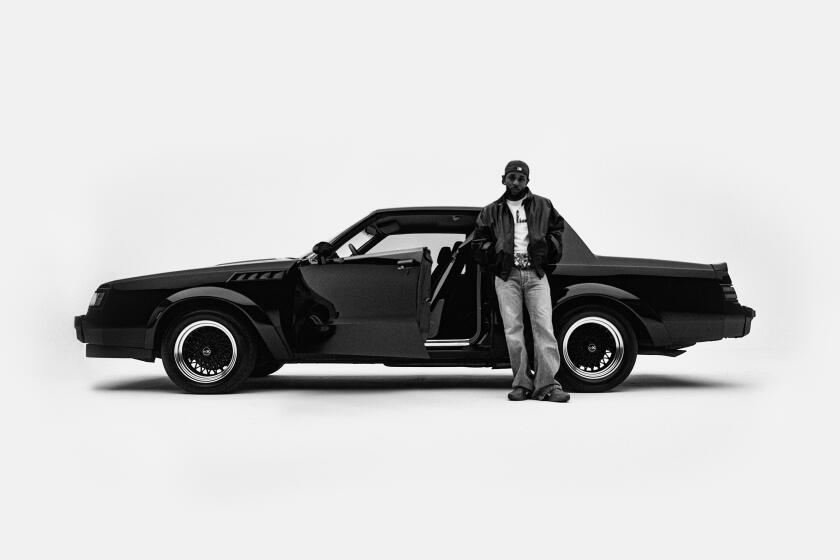Review: BigBang explodes K-Pop convention at the Honda Center
- Share via
Pop artists aren’t often regarded as the best and as the most popular group at the same time. In the English-speaking pop world in the last decade, only maybe Adele, Beyonce and Taylor Swift have earned the same, simultaneous caliber of critical praise and concert tickets sold.
In South Korea, however, there is BigBang. The established quintet is one of the most successful boy bands going in all of K-Pop today, with a sound that spans American hip-hop, R&B balladry with a local twist, and the high-octane electronic dance music that defines pop the world over.
Many of its members have had solo hits and breakthrough combinations with other members (frontman G-Dragon has even collaborated with Diplo, Skrillex and Missy Elliott), and their boundary-pushing videos have laced some sex and violence into typically sugar-sweet K-Pop.
SIGN UP for the free Essential Arts & Culture newsletter >>
At the Honda Center on Sunday night in Anaheim, on the band’s first U.S. tour in three years, its members proved why they’ve lasted through this sea change in K-Pop’s place in America, and how they used an absence to re-imagine this stalwart group as one of the most inventive, aesthetically visionary acts in its genre.
Like all good single-gender pop acts, BigBang has a self-evident chemistry from the moment the lads walk on stage (a moment that, in Anaheim, was preceded by a great Quentin Tarantino-style car-chase-gunfight movie starring the band). G-Dragon is the steely-eyed leader, quick to use venomous rapping or a pure falsetto to drive a song; Taeyang is bawdier and rakish; and T.O.P. is his foil: reserved except for when he raps in a baritone growl that can turn a song from catchy to menacing. Seungri, the youngest, is the sweetheart while Daesung is the muppety goofball (a gifted drummer in his own right, he’s definitely their Ringo Starr). They helped make their parent firm YG Entertainment into a global pop powerhouse (which has a similar set of superstars in the all-woman group 2NE1) and blend punk, futurist and formal fashions in atypical ways that make them global style heroes.
All this is well-known for K-Pop fans the world over. But BigBang’s Sunday set escalated the craft of live K-Pop — which sometimes doesn’t live up to the overwhelming enthusiasm of its fans — into a sleeker and more adventurous kind of arena spectacular.
The hits from BigBang’s newest singles-series/album “M.A.D.E.” are, so far, mellower than much of their old ramped-up catalog. “Loser” is a relatively gentle rap song about the depths of self-loathing; “We Like 2 Party” is an unexpectedly sprightly acoustic ballad. But the ways they traded verses and let their personalities define the different parts of the songs added resonant energy on stage.
It’s hard to imagine a band in the U.S., with its relentless limits on genre and demographics, being able to pull off such featherweight ballads and hard-knuckle rapping at the same show. But BigBang did it all: T.O.P. absolutely leveling the crowd with his avant-garde trap single “Doom Dada”; G-Dragon and Taeyang swapping devilish grins on their dual single “Good Boy”; Daesung peeling back his bangs to mug for a close-up Jumbotron camera and later hopping behind the kit for a spin that turned into their fuzzy electro-pop single “Sober.”
This tour (which also stopped in Las Vegas, L.A. and the New York area) is an incredibly significant moment for K-Pop right now. It’s long been the lingua franca of pop in Asia, and is no longer a rising curiosity or Internet subculture in the States. As individual acts, the BigBang members have done stellar jobs of pushing their music, fashions and places in the public eye to challenging new terrain.
But fans know nothing can replace the guys’ day job. If a band like BigBang can keep performing at this caliber of arena dates in America, that old saw of a “crossover” question will be permanently answered. BigBang is clearly bigger than that already.
Follow @AugustBrown for breaking music news.
More to Read
The biggest entertainment stories
Get our big stories about Hollywood, film, television, music, arts, culture and more right in your inbox as soon as they publish.
You may occasionally receive promotional content from the Los Angeles Times.









